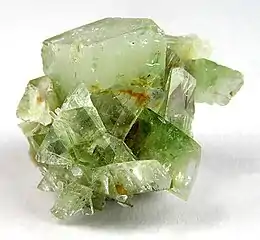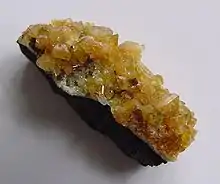Augelite
Augelite is an aluminium phosphate mineral with formula: Al2(PO4)(OH)3. The shade varies from colorless to white, yellow or rose. Its crystal system is monoclinic.[3]
| Augelite | |
|---|---|
 | |
| General | |
| Category | Phosphate mineral |
| Formula (repeating unit) | Al2(PO4)(OH)3 |
| Strunz classification | 8.BE.05 |
| Crystal system | Monoclinic |
| Crystal class | Prismatic (2/m) (same H-M symbol) |
| Space group | C2/m |
| Unit cell | a = 13.124(6), b = 7.988(5) c = 5.0633(3) [Å] β = 112.25(2)°; Z = 4 |
| Identification | |
| Color | Colorless to white, may be yellowish to pale rose, greenish |
| Crystal habit | Tabular to prismatic or acicular crystals; massive |
| Cleavage | Perfect on {110}, good on {201}, imperfect on {001} and {101} |
| Fracture | Uneven |
| Tenacity | Brittle |
| Mohs scale hardness | 4 - 4.5 |
| Luster | Vitreous, pearly on {110} cleavage |
| Streak | White |
| Diaphaneity | Transparent |
| Specific gravity | 2.696 |
| Optical properties | Biaxial (+) |
| Refractive index | nα = 1.574 nβ = 1.576 nγ = 1.588 |
| Birefringence | δ = 0.014 |
| 2V angle | Measured: 50° |
| References | [1][2] |
It was first described by Christian Wilhelm Blomstrand for an occurrence in Västanå iron mine at Scania, Sweden in 1868 and derives its name from the Greek αύγή in reference to its pearly lustre.[1][2]
It occurs as a product of metamorphism of phosphate bearing peraluminous sediments and in high-temperature hydrothermal ore deposits. It occurs in association with attakolite, svanbergite, lazulite, hematite, trolleite, berlinite, rutile, pyrophyllite, baryte, arsenopyrite, stannite, pyrite, andorite, cassiterite and zinkenite.[1]
References
- Handbook of Mineralogy
- Mindat.org
- Richard V. Gaines, H. Catherine W. Skinner, Eugene E. Foord, Brian Mason, and Abraham Rosenzweig: "Dana's new mineralogy", p. 851. John Wiley & Sons, 1997

Augelite from the Dawson Mining District, Yukon, Canada
| Wikimedia Commons has media related to Augelite. |
This article is issued from Wikipedia. The text is licensed under Creative Commons - Attribution - Sharealike. Additional terms may apply for the media files.
